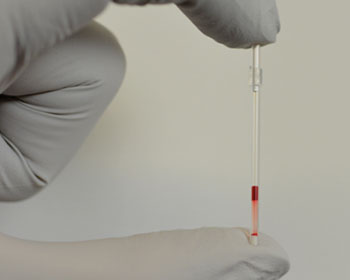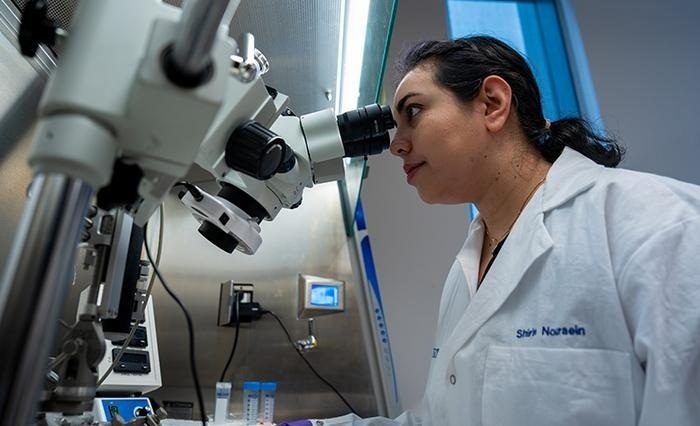Novel Diagnostic Test Developed for Sickle Cell Disease
|
By LabMedica International staff writers Posted on 08 Sep 2014 |

Image: Scientists have developed a simple new test for sickle cell disease that provides results in just 12 minutes and costs as little as USD 0.5 — far simpler, faster, and cheaper than current tests (Photo courtesy of Dr. A. Kumar and Harvard University).
Researchers have developed a simple, rapid, low-cost test for sickle cell disease (SCD) that could enable large-scale global screening also of children in underprivileged regions, such as those in Africa and India.
A team led by Harvard University (Cambridge, MA, USA) postdoctoral fellow Ashok Kumar, PhD, and Prof. George Whitesides have developed a low-cost, novel test for SCD that provides results in just 12 minutes. “The tests we have today work great, they have a very high sensitivity,” said Dr. Kumar, “But the equipment needed to run them costs in the tens of thousands of dollars, and they take hours to run. That’s not amenable to rural clinics, or even some cities, where the medical infrastructure isn’t up to the standards we see in the US.” Although extensive analysis will be needed to determine whether the test is accurate enough to use in the field, when run against over 50 known clinical samples — 26 positive and 26 negative — it showed good sensitivity and specificity.
A chance meeting with Dr. Thomas Stossel, MD at Harvard-affiliated Brigham and Women’s Hospital had steered Dr. Kumar into focusing on SCD. “Initially, we started off working on malaria, because we thought when parasites invaded the cells, it would change their density,” he said, “But when I met Tom Stossel on a panel at the Harvard Medical School, he said, ‘You need to work on sickle cell.’ He’s a hematologist by training and has been working with a nonprofit in Zambia for the past decade, so he’s seen the need from the lack of a diagnostic tool.”
The method design is simple and works by connecting two long-understood principles. First, sickle cell red blood cells (RBCs) are denser than normal RBCs; second, many polymers, when mixed in water, automatically separate into layers ordered by density. Conventional methods to separate cells by density have relied on layering liquids with different density by hand. The new insight was to use the self-forming density layers. “When you mix the polymers with water, they separate just like oil and water,” said Dr. Kumar, “Even if you mix it up, it will still come back to those layers.” When the test was run with infected blood, the results were unmistakable. While healthy RBCs settled in the tubes at specific levels, the dense RBCs from blood infected with sickle cell settled significantly lower. The band of RBCs could clearly be seen by eye.
Next, “We wanted to make the test as simple as possible,” Dr. Kumar explained, “The idea was to make it something you could run from just a finger prick. Because these gradients assemble on their own, that meant we could make them in whatever volume we wanted, even a small capillary tube.” The design they chose is barely larger than a toothpick. In the field, running the test is as simple as uncapping the tube, pricking a patient’s finger, and allowing the blood to wick into the tube.
“There were studies recently that showed in sub-Saharan Africa between 50%-90% of the children born with sickle cell disease die before the age of 5,” said Dr. Kumar, “Whereas in the US people don’t die from this disease as children, they can still live a full life. So my hope is that if this test is effective, it can make [at least] some small dent in those numbers.”
The test is described in the journal Proceedings of the National Academy of Sciences of the United States of America (PNAS), September 2, 2014, online before print.
Related Links:
Harvard University
A team led by Harvard University (Cambridge, MA, USA) postdoctoral fellow Ashok Kumar, PhD, and Prof. George Whitesides have developed a low-cost, novel test for SCD that provides results in just 12 minutes. “The tests we have today work great, they have a very high sensitivity,” said Dr. Kumar, “But the equipment needed to run them costs in the tens of thousands of dollars, and they take hours to run. That’s not amenable to rural clinics, or even some cities, where the medical infrastructure isn’t up to the standards we see in the US.” Although extensive analysis will be needed to determine whether the test is accurate enough to use in the field, when run against over 50 known clinical samples — 26 positive and 26 negative — it showed good sensitivity and specificity.
A chance meeting with Dr. Thomas Stossel, MD at Harvard-affiliated Brigham and Women’s Hospital had steered Dr. Kumar into focusing on SCD. “Initially, we started off working on malaria, because we thought when parasites invaded the cells, it would change their density,” he said, “But when I met Tom Stossel on a panel at the Harvard Medical School, he said, ‘You need to work on sickle cell.’ He’s a hematologist by training and has been working with a nonprofit in Zambia for the past decade, so he’s seen the need from the lack of a diagnostic tool.”
The method design is simple and works by connecting two long-understood principles. First, sickle cell red blood cells (RBCs) are denser than normal RBCs; second, many polymers, when mixed in water, automatically separate into layers ordered by density. Conventional methods to separate cells by density have relied on layering liquids with different density by hand. The new insight was to use the self-forming density layers. “When you mix the polymers with water, they separate just like oil and water,” said Dr. Kumar, “Even if you mix it up, it will still come back to those layers.” When the test was run with infected blood, the results were unmistakable. While healthy RBCs settled in the tubes at specific levels, the dense RBCs from blood infected with sickle cell settled significantly lower. The band of RBCs could clearly be seen by eye.
Next, “We wanted to make the test as simple as possible,” Dr. Kumar explained, “The idea was to make it something you could run from just a finger prick. Because these gradients assemble on their own, that meant we could make them in whatever volume we wanted, even a small capillary tube.” The design they chose is barely larger than a toothpick. In the field, running the test is as simple as uncapping the tube, pricking a patient’s finger, and allowing the blood to wick into the tube.
“There were studies recently that showed in sub-Saharan Africa between 50%-90% of the children born with sickle cell disease die before the age of 5,” said Dr. Kumar, “Whereas in the US people don’t die from this disease as children, they can still live a full life. So my hope is that if this test is effective, it can make [at least] some small dent in those numbers.”
The test is described in the journal Proceedings of the National Academy of Sciences of the United States of America (PNAS), September 2, 2014, online before print.
Related Links:
Harvard University
Latest Hematology News
- Platelet Activity Blood Test in Middle Age Could Identify Early Alzheimer’s Risk
- Microvesicles Measurement Could Detect Vascular Injury in Sickle Cell Disease Patients
- ADLM’s New Coagulation Testing Guidance to Improve Care for Patients on Blood Thinners
- Viscoelastic Testing Could Improve Treatment of Maternal Hemorrhage
- Pioneering Model Measures Radiation Exposure in Blood for Precise Cancer Treatments
- Platelets Could Improve Early and Minimally Invasive Detection of Cancer
- Portable and Disposable Device Obtains Platelet-Rich Plasma Without Complex Equipment
- Disposable Cartridge-Based Test Delivers Rapid and Accurate CBC Results
- First Point-of-Care Heparin Monitoring Test Provides Results in Under 15 Minutes

- New Scoring System Predicts Risk of Developing Cancer from Common Blood Disorder
- Non-Invasive Prenatal Test for Fetal RhD Status Demonstrates 100% Accuracy
- WBC Count Could Predict Severity of COVID-19 Symptoms
- New Platelet Counting Technology to Help Labs Prevent Diagnosis Errors
- Streamlined Approach to Testing for Heparin-Induced Thrombocytopenia Improves Diagnostic Accuracy
- POC Hemostasis System Could Help Prevent Maternal Deaths
- New Test Assesses Oxygen Delivering Ability of Red Blood Cells by Measuring Their Shape
Channels
Clinical Chemistry
view channel
Chemical Imaging Probe Could Track and Treat Prostate Cancer
Prostate cancer remains a leading cause of illness and death among men, with many patients eventually developing resistance to standard hormone-blocking therapies. These drugs often lose effectiveness... Read more
Mismatch Between Two Common Kidney Function Tests Indicates Serious Health Problems
Creatinine has long been the standard for measuring kidney filtration, while cystatin C — a protein produced by all human cells — has been recommended as a complementary marker because it is influenced... Read moreMolecular Diagnostics
view channel
New Serum Marker-Editing Strategy to Improve Diagnosis of Neurological Diseases
Tracking gene-expression changes in the brain is crucial for understanding neurological diseases, yet current monitoring tools are invasive or unable to capture subtle activity shifts over time.... Read more
World’s First Genetic Type 1 Diabetes Risk Test Enables Early Detection
Type 1 Diabetes (T1D) affects more than eight million people worldwide, with numbers expected to rise sharply. While most cases are genetically driven, only one in ten patients has a family history, making... Read moreImmunology
view channel
Gene Signature Test Predicts Response to Key Breast Cancer Treatment
DK4/6 inhibitors paired with hormone therapy have become a cornerstone treatment for advanced HR+/HER2– breast cancer, slowing tumor growth by blocking key proteins that drive cell division.... Read more
Chip Captures Cancer Cells from Blood to Help Select Right Breast Cancer Treatment
Ductal carcinoma in situ (DCIS) accounts for about a quarter of all breast cancer cases and generally carries a good prognosis. This non-invasive form of the disease may or may not become life-threatening.... Read moreMicrobiology
view channelRapid POC Tuberculosis Test Provides Results Within 15 Minutes
Tuberculosis remains one of the world’s deadliest infectious diseases, and reducing new cases depends on identifying individuals with latent infection before it progresses. Current diagnostic tools often... Read more
Rapid Assay Identifies Bloodstream Infection Pathogens Directly from Patient Samples
Bloodstream infections in sepsis progress quickly and demand rapid, precise diagnosis. Current blood-culture methods often take one to five days to identify the pathogen, leaving clinicians to treat blindly... Read morePathology
view channelAI Tool Outperforms Doctors in Spotting Blood Cell Abnormalities
Diagnosing blood disorders depends on recognizing subtle abnormalities in cell size, shape, and structure, yet this process is slow, subjective, and requires years of expert training. Even specialists... Read more
AI Tool Rapidly Analyzes Complex Cancer Images for Personalized Treatment
Complex digital biopsy images that typically take an expert pathologist up to 20 minutes to assess can now be analyzed in about one minute using a new artificial intelligence (AI) tool. The technology... Read moreTechnology
view channel
AI Saliva Sensor Enables Early Detection of Head and Neck Cancer
Early detection of head and neck cancer remains difficult because the disease produces few or no symptoms in its earliest stages, and lesions often lie deep within the head or neck, where biopsy or endoscopy... Read more
AI-Powered Biosensor Technology to Enable Breath Test for Lung Cancer Detection
Detecting lung cancer early remains one of the biggest challenges in oncology, largely because current tools are invasive, expensive, or unable to identify the disease in its earliest phases.... Read moreIndustry
view channel
Abbott Acquires Cancer-Screening Company Exact Sciences
Abbott (Abbott Park, IL, USA) has entered into a definitive agreement to acquire Exact Sciences (Madison, WI, USA), enabling it to enter and lead in fast-growing cancer diagnostics segments.... Read more

























